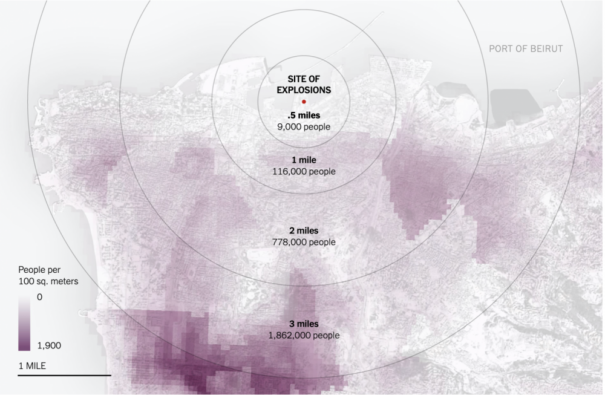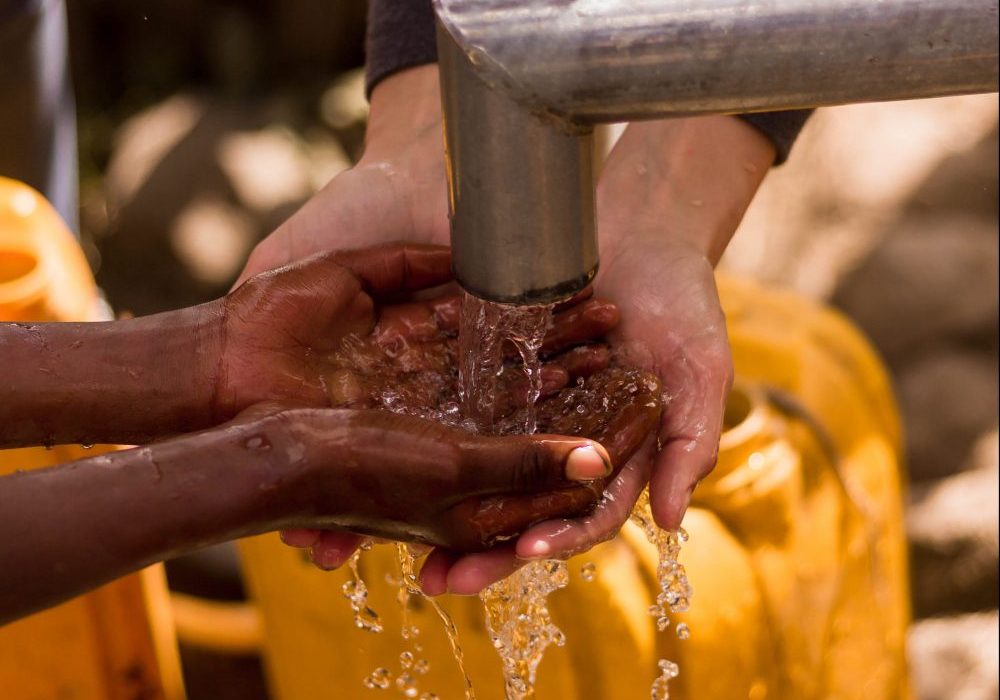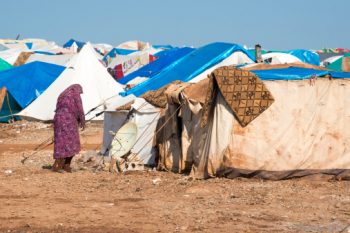

In the early evening (local time) of Aug. 4, 2020, a fire, believed to be in a fireworks factory, led to two explosions in a warehouse holding 3,030 U.S. tons (2,700 metric tons) of ammonium nitrate in the port area of Beirut, Lebanon.
At the end of December 2020, an FBI investigation found that only 551 U.S. tons (500 metric tons) exploded. There have been no reports accounting for the rest of the fertilizers. The events were documented in this video from the New York Times and in a New York Times interactive story.
For comparison, Timothy McVeigh used two tons of ammonium nitrate in the Oklahoma City bombing in 1995, which killed 168 people. A research team from The University of Sheffield’s Blast and Impact Engineering Research Group in the United Kingdom, said that this was one of the largest non-nuclear explosions in history. In the study released in early October, they estimated the explosion’s yield as the equivalent of 500 tons of TNT, although it could have been as much as 1.1 kilotons. The blast was equivalent to 1/20th of the size of the atomic bomb used in Hiroshima in 1945.
(Photo source: @Planet via Twitter)
Ammonium nitrate is a common fertilizing agent and the main ingredient in explosives used in mining. The warehouse had been holding this cache of ammonium nitrate since 2014 when it was seized from a Russian cargo ship. According to The New York Times, “Lebanese customs officials wrote letters to the courts at least six times from 2014 to 2017, seeking guidance on how to dispose of the highly combustible material, according to public records cited by a Lebanese lawmaker, Salim Aoun.” They reportedly did not receive a response and because of the nature of the materials were unable to act on their own accord.
Winter rains in early November have increased damages and made living in damaged homes much more challenging.
What was the explosion's impact on communities?
The second blast caused significant damage, including the destruction of buildings and cars for several miles and was heard and felt in Cyprus, 180 miles (290 km) away. It is considered to be equivalent of a 3.3 magnitude earthquake according to the U.S. Geological Survey. At the site of the blast, a hole – 460 feet in diameter – is all that is left of the warehouse. The blast is considered one of the largest non-nuclear explosions in history.

Related reading
Impact story
Who was affected and in what ways?
The death toll for people killed by the explosion has now passed 200 as some of the more than 6,500 injured individuals succumbed to their injuries. Hospitals – including the closest St. George – were destroyed in the blast and others were damaged, including three hospitals in the district of Achrafieh and dozens of primary health centers.
More than 70% of Beirut buildings were affected. The blast damaged at least 70,000 homes, many of which are no longer habitable, leaving at least 300,000 homeless. The prices of aluminum and glass have skyrocketed, pushing many who can’t afford the cost to live in open-air buildings. The affected area around the port was also home to many buildings with significant architectural, historical and cultural meaning; many of them have been damaged or destroyed.
Beirut Gov. Marwan Abboud estimates the total costs to be between $10 and $15 billion, while insured losses could range from $2 billion to $3.5 billion, according to insurance experts.
The blast came on the heels of multiple other crises in Lebanon. As of Dec. 30, Lebanon had nearly 180,000 COVID-19 cases, an increase of nearly 36 times the number of cases that were confirmed when the blast took place. This can be attributed to several issues, including hospitals sustaining damages in the blast and being overwhelmed by those who were injured. Damages to homes prevent people from isolating or quarantining safely. The economic crisis in Lebanon has also, “left many hospitals underfunded. This resulted in hospitals’ limited access to reliable electricity and sufficient personal protective equipment. The healthcare sector has become more dependent on foreign aid, which left Lebanon’s government with even fewer resources.”
According to the United Nations, 55% of the population lives below the poverty line, a threefold increase from 2019. This includes approximately 1.5 million refugees. Electricity blackouts continue to occur daily, food prices have risen by 80% and the national currency has fallen by the same percentage. Poverty and economic insecurity are rising. According to The Guardian, “Nearly half of the country’s population lives below the poverty line and 35% are out of work, according to official statistics. In March, for the first time in its history, Lebanon announced it was defaulting on its debts. It has a national debt of $92 billion – nearly 170% of its GDP – one of the highest debt ratios in the world.”
Israel, at war with Lebanon, shares one border with the country, while the other land border is with Syria, itself destroyed by war. Lebanon relied on the port as a critical component of its food delivery system – 90% of wheat is imported and stored in silo that was destroyed – and other imported products. The silo destruction destroyed 16,535 U.S. tons (15,000 metric tonnes) of wheat. The port is also the key point of access for aid to war-torn Syria.
Lebanon is home to many Syrian refugees and nearly 25% of those live in Beirut. Officially there are just over 800,000 refugees, but unofficially due to changes in border laws, the estimate is as much as 1.5 million. According to UN OCHA, there are one million Syrian refugees and 300,000 Palestinian refugees. At least 46 of those who died were Syrian refugees and at least a dozen more were migrant workers from countries including Ethiopia, Sri Lanka, Bangladesh and Ghana.
On Thursday, Oct. 1, the judge leading a probe into the explosion asked Interpol to detain the captain and the owner of the Russian ship, the MV Rhosus. Despite this, victims’ families protested on Oct. 4, the two-month anniversary of the explosion, to pressure the government to take action and to step up the investigation. On Nov. 12, the 100th day since the explosion, affected communities, families and non-governmental organizations protested the lack of action taken by the judicial inquiry. Charges were laid in early December against Lebanon’s acting prime minister and three former ministers. According to The Guardian, “Caretaker PM, Hassan Diab, and former ministers Ali Hassan Khalil, Ghazi Zaiter and Youssef Fenianos were accused of failing to respond to warnings ahead of the disaster that 2,750 tonnes of ammonium nitrate stored unsafely at the port posed a growing danger to residents. … Up to 30 port officials had been detained as part of the investigation, which was launched amid seething public anger at Lebanon’s politicians and their role in leading the country to the point of economic oblivion – a scenario made even more likely by multibillion dollar losses caused by the blast.”
However, both the French probe and the FBI investigations have not produced any firm conclusions about the cause of the blast.
Medical supports
Several hospitals and dozens of primary health centers were damaged in the blast and one hospital was destroyed. Hospitals were already full because of COVID-19 and short on blood and other medical products.
The national quarantine warehouse where all vaccines, cold chains and acute and chronic diseases medications were stored suffered damage. While most of the vaccines were rescued, the warehouse itself needs repairs.
There is also an extensive shortage of personal protective equipment (PPE) as much of it had been stored at the port. Ten containers of PPE were destroyed.
Housing
Hundreds of thousands of people are homeless. While some housing repairs will be simple, those closest to the blast suffered extensive damage and will need expensive construction assistance. The increased costs of supplies and the devaluation of the currency is making rebuilding more challenging.
Job recovery
The blast occurred in a highly industrial area but also impacted commercial districts. Many people were already unemployed because of COVID-19 and Lebanon’s economic crisis. Jobs and support for industries, retails and nonprofits will be important components to rebuilding.
Infrastructure
Assistance is needed to rebuild government and community infrastructure, especially given the economic crisis. The destruction at the port is of key importance. Debris removal will be another key part of rebuilding the infrastructure and providing access to roads and buildings.
Cash assistance
Given the extensive damage and the economic crisis, cash assistance will be critical to help people rebuild their livelihoods, homes and sustain their families.
Nutrition and Food Security – Food costs have risen dramatically in recent months and at least 80% of all food, including 90% of wheat, a key staple, was imported through the port. There are significant risks for hunger as people rebuild.
Migrant workers
Even before the explosion, the economic crisis meant that many people could no longer afford their hired hands, such as nannies. The cost of return to home countries is very expensive and Lebanon requires exit payments/fees. Support should include both emergency needs (food/shelter) and funds to return home.

The Center for Disaster Philanthropy (CDP) has a Global Recovery Fund that provides an opportunity for donors to meet the ongoing and ever-expanding challenges presented by global crises.
Contact CDP
Philanthropic contributions
If you would like to make a donation to the CDP Global Recovery Fund, please contact development.
Recovery updates
If you are a responding NGO or a donor, please send updates on how you are working on recovery from this disaster to Tanya Gulliver-Garcia.
Donor recommendations
If you are a donor looking for recommendations on how to help with disaster recovery, please email Regine A. Webster.
Philanthropic and government support
At a virtual summit on Sunday, Aug. 9, hosted by French President Emmanuel Macron, just over $300 million was pledged by international donors. The UN’s Flash Appeal was launched on Aug. 14; as of Dec. 17, it stood at 80% funded – $156.4 million of $196.6 million.
CDP has made two grants through the Global Recovery Fund, one in partnership with a CDP donor that wishes to remain anonymous:
- Miyamoto Global Disaster Relief received a $50,000 grant to repair housing units that were damaged by the devastating explosion. The program will leverage Miyamoto Relief’s engineering expertise and focus on homes that are of historical or cultural significance and have suffered structural damages (as opposed to lighter repairs, such as replacing doors and windows).
- Cooperative Assistance for Relief Everywhere (CARE) also received a $50,000 grant. CARE will be using cash and vouchers to address food security and livelihood, repairs and rehabilitation to homes (with a particular focus on safe shelter for vulnerable individuals and protection and gender activities including counseling.
The Charles Stewart Mott Foundation provided a $100,000 grant to the American Near East Refugee Aid organization, which facilitated and supplied critical shipments of medical equipment as well as capacity building support to the hospitals and health centers in Beirut.
The Seattle Foundation made a $1,500 grant to Oxfam America to help its efforts to respond to the explosion.
Resources

Water, Sanitation and Hygiene (WASH)
Water is one of the most necessary elements for life, yet according to the World Health Organization/UNICEF, 2.1 billion people lack access to safely managed drinking water. In addition, 4.5 billion people lack safely-managed sanitation facilities. Water, sanitation and hygiene (WASH) principles are of tremendous concern in everyday life, but can be heightened during an emergency or disaster.

Nutrition
In the immediate wake of a natural disaster, feeding and sheltering are two of the major issues that are addressed immediately following evacuation or search and rescue operations. These are core elements of survival and are an important area for government and nongovernmental responders.

Emergency and Interim Shelter
After a disaster, shelter is more than a place to rest, it is a place of security, access to food, water and medical treatment. A place to start recovering after a disaster.